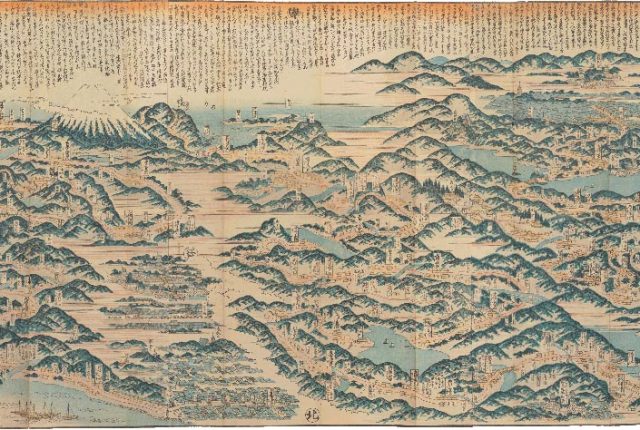
Date/Time
Friday, February 2, 2024
10:00 am PST – 5:30 pm PST
Location
UCLA William Andrews Clark Memorial Library
2520 Cimarron Street
Conference organized by Kristopher W. Kersey, University of California, Los Angeles
The highly urbanized nature of the Edo period—with its three metropolises of Osaka, Kyoto, and Edo—resulted in massive changes to the natural and built environments. The bustling economies of these cities fueled wide-reaching networks of production, trade, and environmental exploitation. The concept of nature itself, as well as the iconography of natural history, were likewise in flux. Accordingly, this conference seeks papers that will contribute to the emergent discourse of ecological art history by directing attention to the material and ecological horizons of early modern Japanese art. What were the aesthetics of environmental exploitation? How were industry and labor depicted? What were the religious perspectives on ecological manipulation? How were materiality and ecology themselves conceived? Where is the intersection of ecological ethics and artistic production?
Speakers
Kit Brooks, National Museum of Asian Art, Smithsonian Institution
Chelsea Foxwell, University of Chicago
Greg Levine, University of California, Berkeley
Rachel Saunders, Harvard Art Museums
Christian Tagsold, Heinrich Heine University Düsseldorf
Nobuko Toyosawa, Oriental Institute of the Czech Academy of Sciences
About Open Edo: Diverse, Ecological, and Global Perspectives on Japanese Art, 1603–1868
The art of Japan’s Edo period (1603–1868) presents a paradox. On the one hand, the nineteenth-century proliferation of ukiyo-e—polychrome woodblock prints of the “floating words” of theater and sex work—made the popular visual culture of this city a familiar component of modern art in the nineteenth and twentieth centuries. Yet the outsize fascination with ukiyo-e outside Japan has sorely obscured Edo’s far more diverse social, material, and artistic landscapes. In an effort to countervail the enduring stereotypes of early modern Japanese art, Open Edo will present a suite of conferences addressing three interlinked themes: the representation and agency of marginalized groups, the ecological horizons of artistic production, and the ongoing need to counter the myth that Japan in early modernity was somehow disconnected from the rest of the world. Throughout the year-long series, the focus will be both historical and historiographical inasmuch as Open Edo asks how Japanese art history might challenge the discourse of early modernity writ large.
Program Schedule
9:30 a.m.
Morning Coffee and Registration
10:00 a.m.
Director’s Welcome
Bronwen Wilson, University of California, Los Angeles
Opening Remarks
Kristopher W. Kersey, University of California, Los Angeles
10:15 a.m.
Panel 1
Moderator: Kristopher W. Kersey, University of California, Los Angeles
Greg Levine, University of California, Berkeley
“‘Close Looking,’ but at What? Hasegawa Tōhaku’s Pine Grove and ‘Attentional Deviance’”
10:45 a.m.
Rachel Saunders, Harvard Art Museums
“The Birds, Flowers, and Botany of Edo Rinpa”
11:15 a.m.
Discussion
11:45 a.m.
Lunch
Display of Clark Library materials in the North Book Room
1:00 p.m.
Panel 2
Moderator: William Marotti, University of California, Los Angeles
Chelsea Foxwell, University of Chicago
“What Are Bugs Doing in Edo-Period Paintings?”
1:30 p.m.
Kit Brooks, National Museum of Asian Art, Smithsonian Institution
“Morphing into Madness: Shifting Perceptions of the Japanese Wolf”
2:00 p.m.
Discussion
2:30 p.m.
Coffee break
3:00 p.m.
Panel 3
Moderator: Kendall Brown, California State University Long Beach
Christian Tagsold, Heinrich Heine University Düsseldorf
“The Thousand Gardens of Edo: Exploring the Nature of the Cultivated Environment”
3:30 p.m.
Nobuko Toyosawa, Oriental Institute of the Czech Academy of Sciences
“The Place of Ecology in Matsudaira Sadanobu’s Gardens”
4:00 p.m.
Discussion
4:30 p.m.
Break
4:40 p.m.
Plenary Discussion (all speakers)
5:30 p.m.
Reception
The conference is free to attend with advance registration, and will be held in-person at the Clark Library. Registration will close on Monday, January 29 at 5:00 p.m. Seating is limited at the Clark Library; walk-in registrants are welcome as space permits.
Image: Panoramic Map of the Tōkaidō Highway. Shōtei Kinsui, drawn by Kuwagata (better known as Keisai). Published by Sanoya Ichigorō, Izumiya Hanbei, and Izumoji Manjirō, n.d. (likely 1810). Polychrome xylography, 52 x 24 inches. Richard C. Rudolph Collection of Japanese Maps, Special Collections, UCLA Library.

